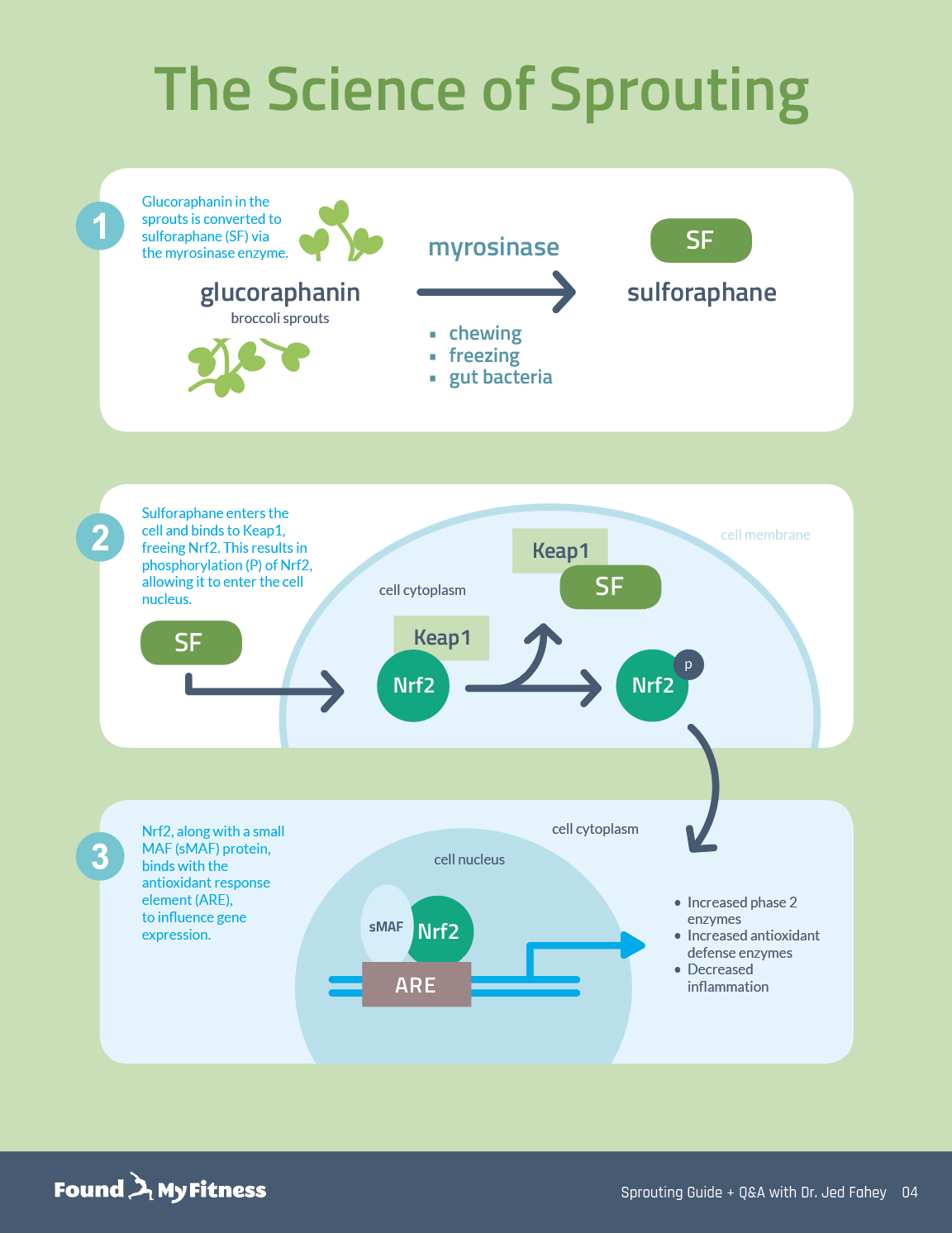Sulforaphane increases detoxification of air pollutants | Jed Fahey
Enter your email to get our 15-page guide to sprouting broccoli and learn about the science of chemoprotective compount sulforaphane.
Broccoli sprouts are concentrated sources of sulforaphane, a type of isothiocyanate. Damaging broccoli sprouts – when chewing, chopping, or freezing – triggers an enzymatic reaction in the tiny plants that produces sulforaphane.

Get the full length version of this episode as a podcast.
This episode will make a great companion for a long drive.
Robust clinical evidence has demonstrated that sulforaphane increases the production of mercapturic acid metabolites of benzene and acrolein, known carcinogens present in air pollution and smoke from fires. These effects manifest shortly after sulforaphane administration in a dose-dependent manner and are sustained, even after several months. They also demonstrate that sulforaphane doesn't exhaust the body's capacity to protect itself from environmental threats and suggest that regular consumption of sulforaphane in foods or dietary supplements protects against future toxic exposures. In this clip, Dr. Jed Fahey describes how sulforaphane promotes the excretion of toxicants in air pollution.
[Dr. Patrick]: The next question was, "If I can't consume broccoli sprouts daily, how beneficial is it to consume them only after exposure to heavy air pollutants? As a firefighter, I am exposed to a lot of carcinogens during a fire and I am wondering if it's beneficial to only take them post fire calls and for how many days?"
[Dr. Fahey]: Yeah, another great question. And to the firefighter that asked that, thank you for your service. It's been a rough year for firefighters out West, that's for sure.
So my best guess is that taking them regularly, or taking a supplement, in order to prime your system and get your antioxidant and detoxication system ready for the regular assaults that you're laying on your body, it would probably be wise. I think this is a case where you should remember that you...if we're talking about carcinogens or toxins or oxidant chemicals, you never really know when you're being attacked by those vicious chemicals. And I'm actually not exaggerating, I mean there are a lot of nasty chemicals in smoke certainly from home fires and even from wildfires.
So there's... You know, if you look at the analogy to wearing seat belts, you know, you wear a seat belt not because you plan on getting in an accident, but it's prophylactic. And I think you could make a similar argument, if you know you're regularly blasting your lungs and your body with the components of smoke, you could make an argument that priming your system to get that response maximally geared up would be a good thing.
One thing we do know from our work in China with a study of air pollution and the effects of sulforaphane on that is that you don't fatigue, and this is fortunate, but you don't fatigue the biochemical response system. So we gave...for 12 weeks we gave daily glucoraphanin and sulforaphane, and monitored the upregulation of this protective response, and did not really see any fatiguing of the response of that system.
So a short answer then is...to the firefighter, is yeah, I think taking a supplement regularly would be... Obviously you're not going to make broccoli spouts when you're out doing fire calls. But, so probably supplements in your case would be a good...you know, a good thing. I'm not a physician, I'm not prescribing them to you, but that's the way I feel about it, yeah.
- [Dr. Patrick]: Jed, if I just could comment, as well. Your 12-week study was extremely relevant to not only firefighters, but, you know, people particularly on the West Coast in California and, you know, Oregon, you know, people that are being exposed to these wildfires that are breathing in acrolein, which is heavily in smoke, and benzene. But, you know, and your studies showed that within 24 hours benzene excretion was excreted by 60% and acrolein study was increased...or acrolein excretion was increased by 20%...about 23%.
And so I guess also the question is let's say, you know, the firefighter or whoever isn't going to take it daily, but, you know, even within a few days of knowing they're going on call or whatever. Do you think that would even be beneficial? Because, I mean, it literally was within 24 hours, your study in China.
- [Dr. Fahey]: Yeah, yeah. So I do. I mean these... Obviously there is some time lag between the time you ingest glucoraphanin or sulforaphane and the time the enzymes are upregulated or respond. It's quite short though and, you know, even after a couple of hours some of those enzymes are cranking up.
So the answer to your question is yes. And, you know, the main sort of situation where I think, you know, you might almost have to have it onboard before an event is some of the neuronal injury models, like when we talk about traumatic brain injury and spinal cord injury. There is an absolutely pronounced effect of sulforaphane that we have seen in a variety of studies, we and others. When I say "we," I always mean we and other people. Or maybe I wasn't even involved in that study, in this case. But we see an effect. Obviously if you have that sort of injury and you're looking for the rapid response of sulforaphane, it would be ideal to have had it onboard your body beforehand. But one of the things that appears evident is that with neuronal injury, even getting it right after the injury may have some value.
So with the fire analogy, or the fire situation, absolutely. We showed that the response was upregulated quickly and it was maintained and, as you say, detoxication of two out of the three major pollutants that we looked at happened to a substantial degree.
And I should mention this was work that my colleague Tom Kensler started a long time ago in China. And we joined a network in the...I guess in about 2001. And so we've been involved with it for many years now and the final studies there are going to be published soon, I hope.
- [Dr. Patrick]: Just amazing work, I love those studies. And the fact that the 12 weeks there was no exhausting of the upregulation of these important detoxication enzymes, that's really profound that they were maintained within that whole 12-week. It wasn't like it was a short-term effect that went away. Also it's...as we're going to discuss probably in a couple of minutes about a lot of the preclinical studies on the effects of sulforaphane in Alzheimer's disease, there's been a just onslaught of new research that has shown air pollution is contributing to neurodegenerative diseases, starting in early life.
So there was a study in Mexico City where air pollution is terrible. And children...so they've been doing postmortem, you know, studies looking in the brain of unfortunately infants and children and young adolescents that have died for whatever reason and they have amyloid beta plaques in their brain as early as infancy, and other, you know, pathological changes in the brain going on early, early in life, which is really unfortunate. So I think that the possibility of something like moringa or sulforaphane or Brussels sprouts, you know, to help with excreting these, you know, toxic compounds and even in other potential ways improving brain health is really exciting.
The simplest unsaturated aldehyde, created by the burning of glycerol in animal fat. Acrolein, a toxic, colorless liquid, is a strong irritant for the skin, eyes, and nasal passages of humans. It has a disagreeable, acrid smell, easily recognizable as the odor associated with burning fat.
A neurodegenerative disorder characterized by progressive memory loss, spatial disorientation, cognitive dysfunction, and behavioral changes. The pathological hallmarks of Alzheimer's disease include amyloid-beta plaques, tau tangles, and reduced brain glucose uptake. Most cases of Alzheimer's disease do not run in families and are described as "sporadic." The primary risk factor for sporadic Alzheimer's disease is aging, with prevalence roughly doubling every five years after age 65. Roughly one-third of people aged 85 and older have Alzheimer's. The major genetic risk factor for Alzheimer's is a variant in the apolipoprotein E (APOE) gene called APOE4.
A molecule that inhibits oxidative damage to DNA, proteins, and lipids in cells. Oxidative damage plays a role in the aging process, cancer, and neurodegeneration. Many vitamins and plant-based compounds are antioxidants.
An aromatic hydrocarbon compound produced during the distillation and burning of fossil fuels, such as gasoline. It is also present in the smoke from forest fires, volcanoes, and cigarettes. Benzene is a carcinogen that targets the liver, kidney, lung, heart, and brain and can cause DNA strand breaks, chromosomal damage, and genetic instability.
Any of a group of complex proteins or conjugated proteins that are produced by living cells and act as catalyst in specific biochemical reactions.
A glucosinolate (see definition) found in certain cruciferous vegetables, including broccoli, Brussels sprouts, and mustard. Glucoraphanin is hydrolyzed by the enzyme myrosinase to produce sulforaphane, an isothiocyanate compound that has many beneficial health effects in humans.
An essential mineral present in many foods. Iron participates in many physiological functions and is a critical component of hemoglobin. Iron deficiency can cause anemia, fatigue, shortness of breath, and heart arrhythmias.
A chemical that causes Parkinson's disease-like symptoms. MPTP undergoes enzymatic modification in the brain to form MPP+, a neurotoxic compound that interrupts the electron transport system of dopaminergic neurons. MPTP is chemically related to rotenone and paraquat, pesticides that can produce parkinsonian features in animals.
Highly reactive molecules that have the ability to oxidize other molecules and cause them to lose electrons. Common oxidants are oxygen, hydrogen peroxide, and superoxide anion.
A medication or treatment intended for the prevention of disease.
An isothiocyanate compound derived from cruciferous vegetables such as broccoli, cauliflower, and mustard. Sulforaphane is produced when the plant is damaged when attacked by insects or eaten by humans. It activates cytoprotective mechanisms within cells in a hormetic-type response. Sulforaphane has demonstrated beneficial effects against several chronic health conditions, including autism, cancer, cardiovascular disease, diabetes, and others.
Hear new content from Rhonda on The Aliquot, our member's only podcast

Listen in on our regularly curated interview segments called "Aliquots" released every week on our premium podcast The Aliquot. Aliquots come in two flavors: features and mashups.
- Hours of deep dive on topics like fasting, sauna, child development surfaced from our enormous collection of members-only Q&A episodes.
- Important conversational highlights from our interviews with extra commentary and value. Short but salient.





































































